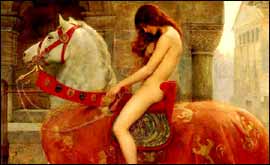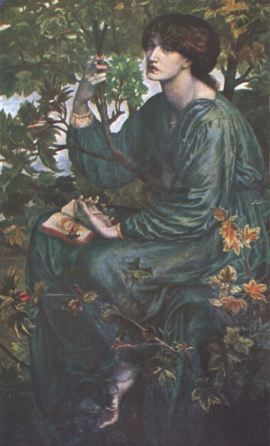Art criticism is something about which I only rarely touch on when something particularly interests me. But in today’s Sunday Telegraph (print version only), Ian Hislop has written an interesting piece called Now I’ll be labelled a pervert on how playwright Andrew Lloyd Webber has been scorned and derided by the British ArtCrit set because he has the temerity to not just collect Victorian and Pre-Raphaelite paintings, but to actually exhibit them to the public.
Having consented to display his collection at the Royal Academy last week, Webber was duly given a good kicking by the critics, who lined up rubbish both the pictures and their owner. The pieces ranged from the hysterical, in the case of Brian Sewell1, to the merely critical, in the case of the critic of this newspaper.
[…]
What appears to really annoy a lot of the critics is the literalism of the paintings: the idea that there is a story or a message, or even something as vulgar as a moral in the artwork, rather than just an impression or a mood or an emotion. Brian Sewell says that Webber has “a literal eye” and that this “has nothing to do with Art”. Nothing at all? This seems rather harsh
1= free registration required
And for me, therein lies the rub. Most art critics hate literal art because literal art can be understood by anyone who takes the time to learn a bit about the context within which the art was created. Now I am not someone who thinks ‘modern art’ is an oxymoron but it is true than much of what passes for art these days is so obscure that it requires an ArtCrit, such as Sewell or Saatchi, to give it some meaning. I guess what I am really saying is that much of what the likes of Tracy Emin does is so devoid of intrinsic meaning that only a professional arbiter of artistic values and taste can tell us poor muggles what the hell it means. No wonder art critics love ‘cutting edge’ modern art!
And now for some art you might be able to figure out for yourself…







Not to be too critical, but it would appear that the critics in this case are alarmed that public are getting arts without the aid and interperation of the high priest, ie. Da Critics.
Who knows, without the more educated one to lead the mob, these rubbles might actually enjoy the pretty pictures, and not getting the underlining message of struggles against capatalists and George W. Bush.
“what passes for art these days is so obscure ”
Please feel free to state the obvious: what passes for art these days is rubbish. The emperor is naked.
The critics’ reaction to this exhibition was drearily predictable.
As far as I can recall, the best five art exhibitions I have been to in the past decade were all similarly rubbished by my intellectual betters in the art mafia.
Indeed, I have reached the point where I react with glee to negative reviews. In my experience, it means there is a fine chance that the show contains work I may possibly enjoy.
I’ll be visiting Mr. Lloyd Webber’s exhibition next week, all being well, and am rubbing my hands in anticipation!
Hey. someone please organize a flash mob to show up at the Royal Academy.
It would be jolly fun, a great chance to see some truely good art, and besides that, it would make the Effete Art Mafia livid with rage.
Personally I like my art to be rather obvious. If art is supposed to be a language, I think most modern art involves the artist simply talking to him/herself. In a language only the artist understands. (If you are speaking and no one can understand you, have you actually said anything?) Perhaps it is a little touch of narcissism.
I think Dave Barry got it right when he commented on most modern public art as “looking like the rusted remains of a helicopter crash” and that no individual would actually buy something like that, rather “it takes the concentrated power of government to erect one of those babies”. (The quotes may be slightly off).
Mr. Barry could have been talking about the whole mess as far as I am concerned.
Literal???
What about the art from that same approximate time period that featured fairies?
That´s in consonance with the travel the society are making towards the “feeling” society.
I have an art background albeit more in Design, i like very much some contemporaries but i cant get the sensation of awe that i get from some Renascentist and Impressionists.
The contemporary art is rather decorativist for me.
If you like this kind of art, and want to see new stuff similar to it, science fiction and fantasy conventions are sometimes called “the last bastion of representational art.” Admittedly, a typical show will have everything from really good down to (no joke) doodles on lined paper, and the subject matter is very much in-genre, but if you find something you like the price is startlingly affordable and the better artists usually work in easily framable sizes (8×10, for example.)
I think the World Science Fiction Convention is in Glasgow in 2005; how I wish I could afford it…
I tend to think that such critics (whether in art, or literature, etc.), are absolutely desperate to validate themselves in any fashion at all.
After all, they are rarely able to actually perform in the genre they claim to serve, so it seems they must work to present themselves as the gatekeepers of ‘true art’, i.e., any art that is accessible to the average person is not true art (if we don’t need them to tell us what art is, their life has no meaning).
With a small handful of exceptions, if a critic doesn’t like the product, that makes the product more valid than if they had kept their mouths shut.
I went to the Lloyd Webber exhibition with my father two weekends ago and apart from one or two pieces, I thought the whole thing was magnificent. The Royal Academy was packed.
I read a review in the Sunday Times and the hatred that came off the page was really quite striking. I know a lot of art critics are tossers but even so, I was taken aback. Maybe the critic was upset by the often optimistic, life-affirming tone of the pieces.
Button: Literal is not the same as realistic. A picture of a fairy or dragon or nymph does not require much interpretation. A picture of St. George & The Dragon can be literal (we look at it and think “Ah, here is George and here is the Dragon”)… I know what they are and what story and architypes they represent within the context of the picture. An abstract ‘George and The Dragon’ may on the other hand requires a bit more thought to get your mind around.
But what does Tracy Emin’s unmade bed represent, other than an unmade bed? As the Stuckists like to say about such matters… any ‘art’ which, if viewed out of the context of an art gallery cannot be recognised as art, is not art.
Some art may be bad art but it is at least art. Some just isn’t art at all.
I agree with Jacob that you are being far too charitable about modern art. The idea that there is some deeper meaning to dirty beds and lobster-shaped telephones so sophistimacated that you need years of training to spot it is fantasy. Modern art is as much an empty con as any other variation of postmodernist mumbo-jumbo.
I won’t go like the average Frog claiming that England is a cultural Tchernobyl & that English painting is a farce. There have been some sublimissime painters: Turner, Gainsborough or Constable.
Yet many French people –wrongly- think that England merely witnessed one âge d’or (1750-1850) between two chasms of tremendous mediocrity. They –rightly- point out that Van Dyck was Flemish & Holbein was a Basler. This kind of condescending, deep-rooted myth may be ascribed to the iconoclastic frenzy displayed by protestant, puritan English people (the Axis of the Good of the time…) who joyfully vandalised medieval religious art. However English enluminure (illumination?) is highly indebted to French & Irish savoir-faire…
The bad reputation –if any- that this side of the Cannel loves to stick on the English painting is also due to the ossified academicism, the fastidious realism, the appalling moralism & the nauseating, cheap junk picturesque typical of the Victorian daubbing.
Fortunately –for England & for us- then came the pre-Raphaelites >>> thanx for that: pre-Raph’ art isn’t kitsch at all.
I do not agree, Peter. There is loads of good modern art just as there is loads of crap Victorian and Pre-Raphaelite art. Just because preposterous things like ‘the unmade bed’ masquerade as art, that does not mean all of what claims to be modern art is also rubbish.
The first victim, when the avant garde becomes the establishment, is generosity towards the viewer. This explains how the art world lost touch over the last century, and followed its particular and obsessive path to irrelevance. As any libertarian could have foreseen, it became a place in which producers and validitors conspired for one another’s interest. They virtually wiped from the record the great representative painters of the late nineteenth and early twentieth century (see http://www.artrenewal.org). They succeeded in developing an exclusive market of wealthy buyers and collectors eager for the mystery and chic of “the flat canvass”. Mystery and chic, of course, belonged to the great natural genius. The idea of learning fro a master, of perfecting the technique necessary for the high art of representationalism, was anathema to them. Now any young turk fresh from a course in art & design can start producing art works right away.
We, for our part, seem too over-awed by all this or just too polite to speak our small truths. It wouldn’t make much difference anyway. An avant garde art industry has no need of us or our decrepid and uncool aesthetic tastes.
I can’t say I’m a fan of Tracy Emin but I really don’t think obscurity is one of her faults. In fact, what so many of those “Young British Artists” do is so screamingly obvious, and doesn’t go further than a one-line joke. As for Emin’s bed, like all of her work it’s just an attempt at self-portraiture – from the state of her bed and the objects that surround it you can pretty much tell what she wants to be conveyed about herself. Whether this has any wider import is another question.
Beautiful stuff. I used to go to art museums to see real Art and have a particular love of the Dutch Masters (in college I had a repro canvas of Night Watch on my wall) and the Impressionists. And, truth be told, I am quite a Dali and Escher fan as well.
Pure form is nice for decoration, but I see it as nothing more than that. It can make for a nice environment by becoming part of the background rather than actually saying anything.
I didn’t think all the critics I read were necessarily uncharitable, but they were often quite sniffy about Victorian art. That’s changing fashion for you. But I don’t suppose it’s that much different from the dislike Peter seems to have for ‘modern art’.
As it goes I don’t care much for visual art full stop… but it seems to me that a lot of modern art is far more literal than we seem to pretend. In fact, it’s so literal as to present itself as a dull and uninteresting one liner. Similarly, the contextual nature behind ‘classical’ art and the stories, constructions and rules which inform them are, to an untrained observer, every bit as inscrutable as those which people slam modern artists for. Every generation has their avant garde, their classicists, their pretenders, their pretenders and their charlatans.
And each have their champions… But then again, that’s criticism for you, I suppose. If you agree with them, you can’t see what’s wrong, if you don’t you can’t see what’s right – which goes for everything from artcrit (what we’re talking about) to politcrit (what we do).
bobbie, that was the most reasoned post i’ve seen in this thread of comments 🙂 you said much of what i was thinking, in a much calmer fashion. thanks!
I guess the main issue when it comes to Art is not perhaps to define it – is it possible to do so even? – but to distinguish between good and bad art. If you’re a post-modernist, now is a good time to go mad, kick and scream. Roger Kimball wrote in one of his books (sorry, no internet link) “Art’s Prospect”:
“I do not like Andy Warhol or Karen Finley or Robert Mapplethorpe or Marcel Duchamp […] But it is silly to deny that what they produced was art. It just doesn’t get us anywhere. This is even true in the case of Duchamp, who intended his dadaist pranks to undermine the very idea of art. It may be unfortunate that anything can be accorded the status of art in our society. It may token an important spiritual breakdown as well as a massive failure of nerve. But the real issue is not whether a given object or behavior qualifies as art but rather whethere it should be regarded as good art. In other words, what we need is not definitional ostracism but informed and robust criticism”
As I mentioned earlier, it is very hard, if not impossible, to define art. Some may agree on one definition, others on another. The reason why it’s almost impossible to define art is that it is very individual how you experience it.
Because of Duchamp’s prank (exhibiting a lavatory urinal and calling it art) and because the Art Establishment accepted it as art, we now have the most stupid junk filling up galleries and museums. And it is supposedly Art. Is it Art? Who can decide? Either way, it’s definately terrible Art.
“The Royal Academy was packed. ”
This struck a nerve.
There was an exhibition about 3 years ago of the Martzenbach collection, at the Israel museum in Jerusalem. Paintings, starting from the 19th century to the present (modern art). All beautiful, colorful paintings, some realistic, some abstract. The remarkable thing about this exhibition were the crowds who overwhelmed the museum. You had to make queue for 2 hours to get in. The exhibition was open for about 6 months, and those 2 hour queues never diminished. I know, I went there for the second time on closing night, and still I had to queue up for 2 hours. Never before had the museum been so crowded.
Which shows that, critics or not, people aren’t dumb, and they can tell beautiful things from junk. One thing the two exhibitions ( Martzenbach and LLoyd Webber) have in common is that they are private collections, paintings the collector bought according to his personal taste.
The usual exhibitions, put together by some curator, who is a member of the Art establishment along with the critics, these exhibitions aren’t packed at all.
It is a truch universally acknowledged that in a world stuffed with pretentious tossers, Brian Sewell is the biggest tosser of the lot.
Pre-Raphaelite art is sublime for the most part, and if Sewell can’t see that then he’s blind. There is nothing more to be said.
Johan,
(…) distinguish between good and bad art
Are you underlying that “good” = “what I like” & “bad = what I dislike” ? If so, you’re not distinguishing anything but sorting out stuff according to your personal taste = supermarket customer approach.
Because of Duchamp’s prank (exhibiting a lavatory urinal and calling it art) and because the Art Establishment accepted it as art, we now have the most stupid junk filling up galleries and museums.
The urinoir by Duchamp wasn’t the first nor the last instance of confrontation of pseudo-subversivity with traditional art-public gathering-place. Was it rather art than sociopolitics applied? Who cares…
Is it Art? Who can decide? Either way, it’s definately terrible Art.
See above.
Still using “definately” when referring to masterpieces &/or pseudo-masterpieces &/or countermasterpieces is contradicted by the very existence of art history & art criticism, both relative, cumulative, contradictive processes based on undefinate considerations on anything eligible to fall into art category.
Without getting to ard a look at the argument itself – most art criticism these days sounds a lot more like a celebrity gossip column with a dram ar three of condecension. It also seems to amount to nothing for most people.
“If it sounds good, it is good” – Duke Ellington
I think the critic of “realism” feels cheated out of a chance to gin up some nonsense and make a quick bob…
Either that, or the “masses” for who art is supposed to elevate above the… er.. mass… will realize the thinness of the tenor and gruel which normally hangs on the walls and occupies reams of paper in ArtNews.
I’m an Architect. I cannot talk my way around my ideas – it simply cant be done. A design is there – the building stands. It doesnt wave back at you. Long have i felt that criticisms, discussions, or even long descriptions of Architecture particularly look foolish and take a great deal of the “nobility” of the design away.
All it takes is a bunch of fat heads to gasbag long enough to make any experience a disappointment.